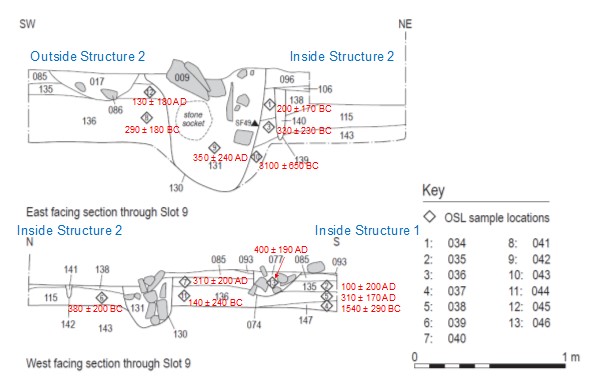Alan Cresswell is a Research Associate at the Scottish Universities Environmental Research Centre, University of Glasgow, whose primary research interests are luminescence analysis and dating of sediments in archaeological and geomorphological investigations and wider interests in environmental radioactivity and dosimetry. Alan is one of the specialist authors for the A75 Dunragit Bypass post-excavation works and is this month’s guest contributor to the blog.
Optically Stimulated Luminescence (OSL) is an approach that can precisely date the deposition of sedimentary layers on archaeological sites. It utilises signals that develop in mineral grains in response to exposure to natural sources of ionising radiation from the surrounding sediments and cosmic rays. When radiation interacts with mineral grains, electrons within the mineral are excited into high energy states, some of which are metastable allowing this charge to be trapped. This trapped charge can be released by exposure to light or heat, emitting light, and with suitable equipment these photons can be counted. The number of photons counted can be related to the radiation dose the mineral had received by calibration in the laboratory using known radiation doses. The combination of received dose and the radiation dose rate gives a time since the trapped electrons in the mineral had last been released, which for materials deposited in many settings would correspond to the time that these minerals had been buried.
Investigations by GUARD Archaeology along the route of the A75 bypass at Dunragit included a set of roundhouses within a former dune system at Myrtle Cottage, with accumulated sand layers within and between these structures. As the Iron Age settlement unearthed at Dunragit was situated in an aeolian environment and as some deposits showed a paucity of organic material this method provided an opportunity for dating that would not otherwise be possible. Thirteen samples of sand were collected during the excavations from layers under structures 1 and 2, between the two structures, within the two structures and from the wall cuts. Quartz grains from these sands were analysed using OSL to determine whether the structures were contemporary, or if not, may indicate a sequence of construction for these two nearby structures.

The layers beneath the structures consist of a natural layer dated to 3100 ± 650 BC, consistent with the mid Holocene tidal high stand for this section of the Solway coast, and an occupation layer dated to 1540 ± 290 BC suggesting human activity on the site significantly before the Iron Age. The wall cut for structure 2 is dated to 350 ± 240 AD, and cuts through occupation layers dated to 400-100BC and into the natural materials. Occupation layers outside structure 2 are approximately contemporary with the wall cut, potentially produced from material excavated from this ditch. The wall cut for structure 1 is dated to 400 ± 190 AD but cuts through the layers outside structure 2, suggesting that the construction of structure 1 slightly post-dates the construction of structure 2.
Overall, this dating evidence confirms the material culture that was recovered from the Iron Age settlement, which included an unusual Roman copper alloy brooch, an Iron Age iron penannular brooch and a rare, curved iron leatherworking knife of likely Roman Iron Age date. The Iron Age settlement at Dunragit, now dated to the centuries around the turn of the First Millennia BC/AD, is a welcome addition to a suite of settlements in Galloway that date to this specific period. These include the variety of settlements around Cults Loch, the large enclosed settlement at Rispain Camp and the promontory fort at Carghidown. These settlements provide useful dating, structural and material culture comparisons with the Iron Age settlement at Myrtle Cottage.
